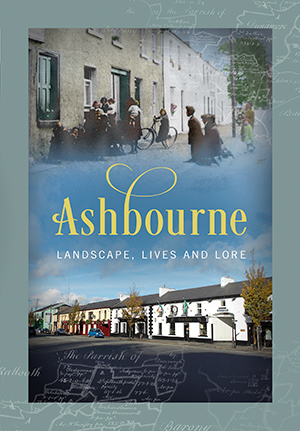ASHBOURNE—landscape, lives and lore
Published in Book Reviews, Book Reviews, Issue 1 (January/February 2021), Reviews, Volume 29BARRY KENNERK (ed.)
Ashbourne Historical Society
€20
ISBN 9781527254633
Reviewed by Stephen Doyle
Stephen Doyle is a history graduate of University College Dublin.
 In his hilariously tongue-in-cheek 1967 article, ‘How Not to Write Local History’, H.P.R. Finberg notes two main problems: first, the tendency among ‘accomplished bunglers’ to eschew referencing and, second, their disastrous foreshortening of perspective. Happily, Ashbourne—landscape, lives and lore manages to avoid both pitfalls.
In his hilariously tongue-in-cheek 1967 article, ‘How Not to Write Local History’, H.P.R. Finberg notes two main problems: first, the tendency among ‘accomplished bunglers’ to eschew referencing and, second, their disastrous foreshortening of perspective. Happily, Ashbourne—landscape, lives and lore manages to avoid both pitfalls.
Ashbourne was developed in 1820 by road-builder Frederick Bourne, and what started as a simple coach stop for weary travellers heading north has since grown into one of County Meath’s largest municipalities. That fact, coupled with the town’s 200th anniversary celebration last year, made the writing of this book almost an inevitability.
David Dickson has recently commented on the patchy and often troublesome course of Irish town histories, which, after a brief burgeoning during the late nineteenth century, entered a long period of stagnation. The town of Ashbourne is no exception. The few fleeting references in trade and travel directories, coupled with the rather sleepy description by Weston St Joyce in 1921 of a quaintly overgrown Castle Street, perhaps tended to militate against further research. This book, however, ploughs a deeper furrow: archaeological discoveries, seventeenth-century landownership and marauding highwaymen, before one even reaches the Battle of Ashbourne in 1916 (the book runs to 413 pages, with endnotes and bibliography).
Edited by Barry Kennerk, this hardback volume is superbly referenced and, to their credit, the contributors cast their net wide—Chief Secretary’s Office Papers at the National Archives of Ireland, memorials of leases from the Registry of Deeds and letters, not to mention wills and ephemera from the National Archives at Kew and the National Library of Ireland. In particular, great use has been made of the Schools’ Folklore Collection at UCD, and the contributors also sought out manuscripts in private hands as well as scores of maps and charts.
The reader encounters four distinct sections—‘From Early Settlement to Village’, which features an illustrated chapter on local archaeology; ‘Voices of Ashbourne’ (a chronological series of interviews); ‘Five Historical Walks around Ashbourne’; and a concluding section, ‘From Village to Town’. The interviews are particularly noteworthy, and many were carried out by the Ashbourne Historical Society after it was founded in 1994. They begin with Joe Armstrong, who remembered the Battle of Ashbourne in 1916:
‘The next day, after school we met about a hundred [soldiers on] horses on the street. They went over to Johnny Duffy’s [a farm on the Ballybin Road] where they put up for the night and it was full of tents.’
A much-needed international flavour comes from interviews with a Syrian refugee and a Moldovan woman who runs a school in the town. When she takes her children on holiday, she says, ‘they won’t eat Russian butter … [they want] Brennan’s bread as well as Tayto crisps’. Such oral testimonies are invaluable and form the human centrepiece of the book.
The Battle of 1916 is undoubtedly important, but prior to Landscape, lives and lore it tended to completely dominate historical commemorations in the town. This book manages to correct such foreshortening by adding a series of chapters about the building of the Ashbourne Road in 1816 and the Tithe War of 1831, while later on the reader learns about the Garden City project of the 1970s and the ‘big snow’ of 1982, which left the village cut off from the outside world and reliant on airlifted food supplies.
Are there any negatives? Informed readers might have wished to learn more about life in Ashbourne during the early days of the Irish Free State (notably absent) and, considering that it was a rural community for much of its history, there is curiously little about farming practices, the Land Commission or Belgian farming techniques during later decades. This is a rather obvious omission in what is an otherwise rounded book. The period of the Second World War is also quite patchy and, although readers do get occasional glimpses from oral testimony, a more cogent narrative might have helped to knit that story together.
For all that, however, Ashbourne—landscape, lives and lore rises above the kind of dry or confusing narrative that so often bedevils local histories. The result is a succinct, well-laid-out book that has a consistent editorial style. The photographs and illustrations are reproduced in high resolution and (unusually for a book of this type) almost all are completely referenced—the pièce de resistance being a high-resolution reproduction of the original 1820 lease which takes up a full two pages.
The Ashbourne Historical Society and Anú Design ought to be justifiably proud of this book. It punches well above its weight for a local history publication and it will undoubtedly serve as a reference guide for many decades to come.
















